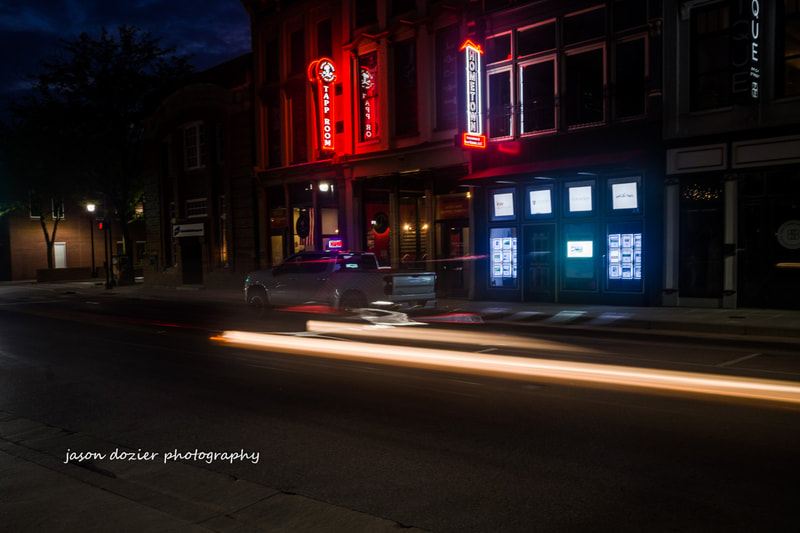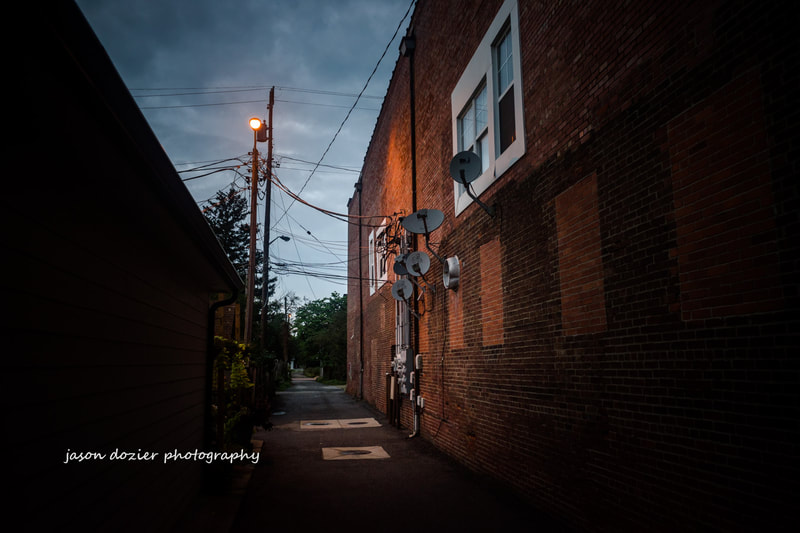|
One of the selling points of the Ricoh GR III compact APS-C camera is the IBIS system (In-Body Image Stabilization), which is claimed to allow the user to handhold up to one second. I put this to the test in this night video, where I'm able to show the long-exposure by using passing cars in a small town, creating light-trails on Main Street.
This was a spur of the moment attempt, but I was very pleased with the results. Having thought through the process, I would have used the 2-second delay shutter to make sure to minimize camera shake even more while holding it in my hands instead of using a tripod. I also only went down to .8 seconds (next step is one full second), as again, I hadn't thought about going as low as possible, it was just an attempt at the time to get a decent light-trail.
In a few other parts of town, I capture what would normally be a very boring alley between buildings, as well as the town Visitor's Center, which is lit up with multi-color lights at night. Both locations wouldn't yield much inspiration during daylight hours, but at night, even the smallest of towns will come alive with the proper street light placement.
While watching this video or looking at the photos, keep in mind, there will be a lot of camera noise in the photos since the ISO has to be jacked up so high - as high as 3200 in some photos, that you can't help but have noise in the lights. One way to avoid this, and get better shots in general, would be to use a tripod, and a longer shutter such as 3-5 seconds, while keeping the ISO as low as possible,usually down to 100. Using a high aperture will usually give you a star effect on the lights as well. But if you do not have a tripod, or time to perform such stabilizing chores, you can still get great night shots, and some cool light trails, as low as .8 or 1 full second handheld.
0 Comments
Your comment will be posted after it is approved.
Leave a Reply. |
Categories
All
Archives
March 2024
|
-
Home
-
Indiana Towns
>
- Arlington, IN
- Attica, IN
- Bloomfield, IN
- Bluffton, IN
- Brazil, IN
- Brownstown, IN
- Broad Ripple, IN
- Centerville, IN
- Columbus, IN
- Cicero, IN
- Connersville, IN
- Covington, IN
- Crawfordsville, IN
- Cynthiana, IN
- Danville, IN
- Delphi, IN
- Edinburgh, IN
- Elnora, IN
- Elwood, IN
- Evansville, IN
- Fishers, IN
- Fountain Square, IN
- Fowler, IN
- Fortville, IN
- Franklin, IN
- Greencastle, IN
- Greenfield, IN
- Greensburg, IN
- Greenwood, IN
- Hartford City, IN
- Haubstadt, IN
- Jamestown, IN
- Kentland, IN
- Knightstown, IN
- Kokomo, IN
- Lebanon, IN
- Liberty, IN
- Marion, IN
- Martinsville, IN
- Mooresville, IN
- Mt Vernon, IN
- Nashville, IN
- Newberry, IN
- New Albany, IN
- New Castle, IN
- New Harmony, IN
- New Palestine, IN
- Newport, IN
- Noblesville, IN
- North Vernon, IN
- Pendleton, IN
- Poseyville, IN
- Petersburg, IN
- Princeton, IN
- Rensselaer, IN
- Roachdale, IN
- Rockville, IN
- Rossville, IN
- Rushville, IN
- Salem, IN
- Scottsburg, IN
- Seymour, IN
- Shelbyville, IN
- Sheridan, IN
- Spencer, IN
- Sullivan, IN
- Swayzee, IN
- Terre Haute, IN
- Versailles, IN
- Vernon, IN
- Vincennes, IN
- Warsaw, IN
- Wabash, IN
- Washington, IN
- Williamsport, IN
- Zionsville, IN
-
Cityscapes
>
- Asheville, NC
- Atlanta, GA
- Baltimore, MD
- Bentonville, AR
- Binghamton, NY
- Birmingham, AL
- Boston, MA
- Bradford, NY
- Buffalo, NY
- Casey, IL
- Charleston, SC
- Charlotte, NC
- Chicago, IL
- Columbus, OH
- Cincinnati, OH
- Davenport, IA
- Detroit, MI
- Farmington, IL
- Goodland, KS
- Hartford, CT
- Indianapolis, IN
- Jackson, MS
- Kansas City, MO
- Knoxville, TN
- Jacksonville, FL
- Jamestown, NY
- Louisville, KY
- Madison, WI
- Memphis, TN
- Miami, FL
- Milwaukee, WI
- Minneapolis, MN
- Montgomery, AL
- Nashville, TN
- Naples, FL
- New Orleans, LA
- New York, NY
- Omaha, NE
- Peoria, IL
- Pittsburgh, PA
- Quitman, MS
- Rochester, NY
- Rock Island, IL
- Savannah, GA
- St Louis, MO
- St Petersburg, FL
- Tampa, FL
- Toledo, OH
- Topeka, KS
- Washington, DC
- Wheeling, WV
- Whiteville, NC
- Rural Landscapes >
-
Street Galleries
>
- 2020 July 30 Ricoh GR III Street Photography 15 Cincinnati 2
- 2020 July 25 Ricoh GR III Street Photography 14 Cincinnati 1
- 2020 July 16 Ricoh GR III Street Photography 13 Chasing the Light
- 2020 July 10 Ricoh GR III Street Photography 12 Snap Focus 4
- 2020 July 7 Ricoh GR III Street Photography 11 Snap Focus 3
- 2020 July 1 Ricoh GR III Street Photography 10 Black and White
- 2020 June 26 Ricoh GR III More Snap Focus for Street Photography
- 2020 June 24 Ricoh GR III Snap Focus for Street Photography
- 2020 June 19 Ricoh GR III Street Photography Portraits
- 2020 June 4 Canon EOS RP How To Take Photographs of a Covered Bridge
- 2020 June 1 Ricoh GR III Portraits In A Small Town
- 2020 May 27 Ricoh GR III Abandoned Bus
- 2020 May 23 Canon RP Camera Review on Worthsville Road
- 2020 May 14 POV 6 Street Photography PhotoWalk Indianapolis
- 2020 May 10 Ricoh GR III AE Highlight-Weighted Mode Review
- 2020 April 22 Ricoh GR III Long Exposure Night Photography Review
- 090919-Indianapolis-Indiana-Street-Photography
- 090119-Plymouth-Indiana-Blueberry-Festival
- 061119-Indianapolis-Indiana-Street-Photography
- 060619-Indianapolis-Indiana-Street-Photography
-
Indiana Towns
>
- Blog
- Podcasts
- Contact
- Photography Services
Services
|
GALLERIES |
|











 RSS Feed
RSS Feed